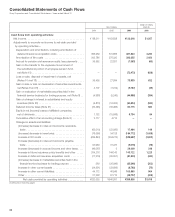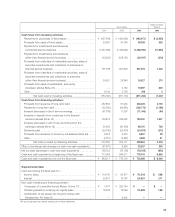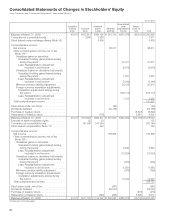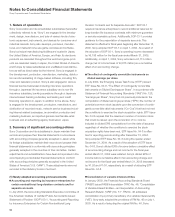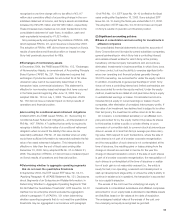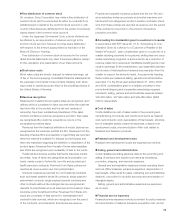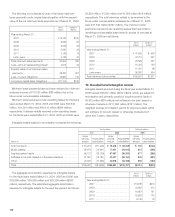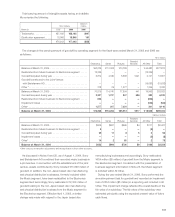Sony 2006 Annual Report Download - page 99
Download and view the complete annual report
Please find page 99 of the 2006 Sony annual report below. You can navigate through the pages in the report by either clicking on the pages listed below, or by using the keyword search tool below to find specific information within the annual report. 97
■ Accounting for computer software to be sold
Sony accounts for software development costs in accordance with
FAS No. 86, “Accounting for the Costs of Computer Software to
Be Sold, Leased, or Otherwise Marketed”.
In the Electronics segment, costs related to establishing the
technological feasibility of a software product are expensed as
incurred as a part of research and development in cost of sales.
Costs that are incurred to produce the finished product after
technological feasibility is established are capitalized and
amortized over the estimated economic life of the product,
which is generally three years. Sony performs periodic reviews
to ensure that unamortized program costs remain recoverable
from future revenue.
In the Game segment, technological feasibility of the underly-
ing software is reached shortly before the products are released
to manufacturing. Costs incurred after technological feasibility is
established are not material, and accordingly, Sony expenses
software development costs for the Game segment as incurred
as a part of research and development in cost of sales.
■ Deferred insurance acquisition costs
Costs that vary with and are primarily related to acquiring new
insurance policies are deferred as long as they are recoverable.
The deferred insurance acquisition costs include such items as
commission, medical examination and inspection report fees.
The deferred insurance acquisition costs for traditional life
insurance contracts are amortized over the premium-paying
period of the related insurance policies using assumptions
consistent with those used in computing policy reserves. The
deferred insurance acquisition costs for non-traditional life
insurance contracts are amortized over the expected life in
proportion to the estimated gross profits.
■ Product warranty
Sony provides for the estimated cost of product warranties at
the time revenue is recognized by either product category group
or individual product. The product warranty is calculated based
upon product sales, estimated probability of failure and esti-
mated cost per claim. The variables used in the calculation of
the provision are reviewed on a periodic basis.
Certain subsidiaries in the Electronics segment offer extended
warranty programs. The consideration received through extended
warranty service is deferred and amortized on a straight-line
basis over the term of the extended warranty.
■ Future insurance policy benefits
Liabilities for future insurance policy benefits are primarily com-
prised of the present value of estimated future payments to
policyholders. These liabilities are computed by the net level
premium method based upon the assumptions such as future
investment yield, morbidity, mortality and withdrawals. These
assumptions are reviewed on a periodic basis. Liabilities for
future insurance policy benefits also include liabilities for guaran-
teed benefits related to certain non-traditional long-duration life
and annuity contracts.
■ Accounting for the impairment of long-lived assets
Sony periodically reviews the carrying value of its long-lived
assets held and used, other than goodwill and intangible assets
with indefinite lives, and assets to be disposed of, whenever
events or changes in circumstances indicated that the carrying
amount may not be recoverable. Long-lived assets to be held
and used are reviewed for impairment by comparing the carrying
value of the assets with their estimated undiscounted future
cash flows. If it is determined that an impairment loss has
occurred, the loss would be recognized during the period. The
impairment loss would be calculated as the difference between
asset carrying value and the present value of estimated net cash
flows or comparable market values, giving consideration to
recent operating performance. Long-lived assets that are to be
disposed of other than by sale are considered held and used
until they are disposed of. Long-lived assets that are to be
disposed of by sale are reported at the lower of their carrying
value or fair value less cost to sell. Reductions in carrying value
are recognized in the period in which the long-lived assets are
classified as held for sale.
■ Derivative financial instruments
All derivatives, including certain derivative financial instruments
embedded in other contracts, are recognized as either assets or
liabilities in the balance sheet at fair value. Changes in the fair
value of derivative financial instruments are either recognized
periodically in income or stockholders’ equity (as a component
of accumulated other comprehensive income), depending on
whether the derivative financial instrument qualifies as a hedge
and the derivative is being used to hedge changes in fair value
or cash flows.
In accordance with FAS No. 133, “Accounting for Derivative
Instruments and Hedging Activities”, the derivative financial
instruments held by Sony are classified and accounted as below.
Fair value hedges
Changes in the fair value of derivatives designated and effective
as fair value hedges for recognized assets or liabilities or unrecog-
nized firm commitments are recognized in earnings as offsets to
changes in the fair value of the related hedged assets or liabilities.
Cash flow hedges
Changes in the fair value of derivatives designated and effective
as cash flow hedges for forecasted transactions or exposures
associated with recognized assets or liabilities are initially
recorded in other comprehensive income and reclassified into



